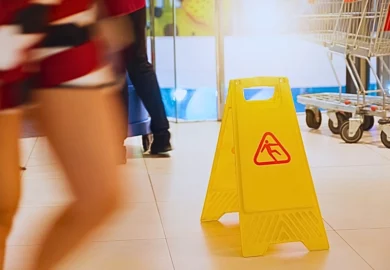Notice in premises liability cases refers to whether the property owner or occupier had knowledge (actual notice) or should have had knowledge (constructive notice) of the dangerous condition that led to an injury. Premises liability cases often hinge on whether the defendant had actual vs. constructive notice of the hazard. Establishing that the property owner or tenant had actual or constructive notice of the hazard that caused the accident is crucial to the outcome of a premises liability case.
Table of Contents

Did you suffer an injury on someone else’s property due to a hazardous condition? Contact the Chicago premises liability lawyers at Ankin Law by dialing 312-600-0000.
What Is the Difference Between Actual and Constructive Notice in Illinois?
The key difference between actual vs. constructive notice in Illinois is in how knowledge of a hazardous condition is acquired, with actual notice involving direct knowledge of the hazard and constructive notice implying the owner had reason to know of the hazard. The evidence required also differs between the two categories of notice.
Actual notice is when a property owner or the owner’s representative is directly aware of a hazardous condition on the property. The awareness can arise from direct communication or observation. On the other hand, constructive notice occurs when the property owner should have known about the hazardous condition, even if they didn’t have direct knowledge. It arises from the hazard having existed long enough or being obvious enough that a reasonable property owner would have discovered and fixed it.
Suppose a broken stair causes you to sustain fall injuries, which were the second leading cause of preventable deaths in Chicago and the rest of Illinois in 2023. If a tenant or customer had informed the property owner about the broken stair, the owner would have had actual notice of the danger. If a handrail that’s been rusted or damaged causes you to have a swimming pool accident, the property owner could be considered to have constructive notice of the dangerous condition.
Actual notice requires definitive evidence demonstrating the responsible party’s direct awareness. This often involves showing documented communications, observations, reports, and other tangible evidence. Establishing constructive notice in premises liability cases often involves showing that the dangerous condition was discoverable through reasonable diligence. It can be inferred from circumstantial evidence, such as the hazard’s size, visibility, length of existence, and maintenance logs.
How Property Owners’ Knowledge Impacts Liability for Injuries
The concept of notice and a property owner’s duty of care to keep the property reasonably safe for those who enter impacts liability for injuries in premises liability cases. If you can show that the property owner had actual or constructive notice of the hazardous condition and breached the duty of care by failing to address the condition, the property owner can be held liable for the resulting injuries.
Lack of notice is a common defense property owners use, arguing that they neither knew of the danger nor had a reasonable way of knowing about it before the accident. Property owners can avoid liability if they can demonstrate they had no notice.
How to Prove Notice in a Premises Liability Case
The property owner is unlikely to admit to having notice. Proving actual vs. constructive notice in a premises liability case usually requires thorough investigations and the collection of evidence like photographs, witness statements, expert testimonies, and maintenance and inspection logs.
Here are some of the ways premises liability lawyers establish notice:
Interviewing Witnesses
Statements from employees, other customers, or bystanders can help prove the property owner’s actual knowledge of the hazard or the hazard’s visibility and duration of existence.
Gathering Photos and Videos
Photos and videos of the hazard, such as a spill that had started drying, can show that the hazard had been present for an extended period. Security camera footage can also prove that the owner or employees observed the hazard without taking corrective action.
Checking Inspection Logs and Maintenance Records
These records can help show inadequate maintenance practices. A lack of inspection or maintenance logs can establish constructive notice.
Requesting Incident Reports and Complaint Records
A premises liability lawyer may request documentation on the hazardous condition or injuries resulting from it. Incident reports, prior complaints, or written communications can serve as proof of notice.
Analyzing Official Weather Reports
Weather reports come in handy in cases like outdoor falls on government property due to snowy or icy surfaces. They can help show how long weather-related hazardous conditions existed or the property owner’s failure to reasonably anticipate and rectify potential hazards due to the weather conditions.
Retaining Experts
Safety engineers, accident reconstructionists, architects, property maintenance specialists, and other experts can provide testimony on whether a property owner’s actions were in line with the industry standards for inspection and maintenance.
An experienced premises liability lawyer will build a strong case to establish the property owner’s notice of the dangerous condition on your behalf and guide you through the legal process. Contact us at Ankin Law for a free case evaluation to determine the type of notice that may be factored into your Chicago premises liability claim.
Actual vs. Constructive Notice FAQs
What Qualifies as Actual Notice in a Slip and Fall Case?
Actual notice occurs when the property owner, manager, or employees were aware of the dangerous condition before the slip and fall accident. Evidence like incident reports, an employee’s testimony, and previous complaints can help prove it.
How Do Courts Determine Constructive Notice of a Hazard?
To determine constructive notice, courts evaluate factors like how long the property hazard existed, visibility of the condition, whether regular inspections were done, and if the property owner had proper protocols to identify and remedy dangerous conditions.
Can I Still File a Claim If the Property Owner Didn’t Know About the Danger?
You can still file a premises liability claim against a property owner even if the owner didn’t have actual knowledge of the dangerous condition. Property owners can still be held liable for harm resulting from an unsafe condition that they should have known about, such as injuries from building code violations or a hazard that had existed for a sufficient period that it should’ve been discovered through reasonable inspections or maintenance. A Chicago premises liability attorney can evaluate your case and help you understand all the legal options available to you.



